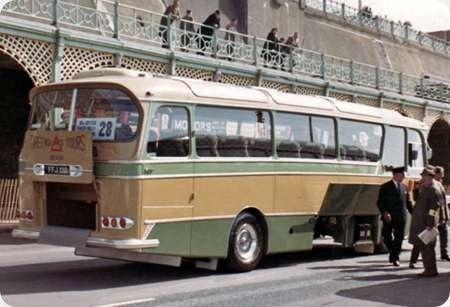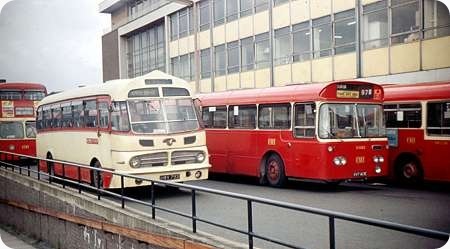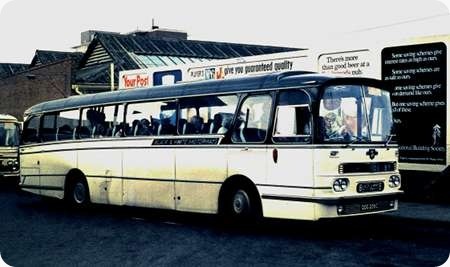Greenslades Tours – AEC Reliance – FFJ 13D
Greenslades Tours
1966
AEC Reliance 2MU4RA
Harrington C40F
Sadly the very last Harrington body to be built, No 3218, was this Grenadier C40F example on an AEC Reliance 2MU4RA chassis for Greenslades Tours of Exeter registration No FFJ 13D. This photo was taken on the 24th April 1966 at the British Coach Rally on Madeira Drive Brighton whilst the Concours judges were making their inspection. The elegant lines of the body and the restrained but attractive livery are even 48 years later a lesson todays designers and colour stylists might well learn lessons from, but being a cynical 75 year old I doubt it will happen.
Photograph and Copy contributed by Diesel Dave
15/09/14 – 07:02
Can’t better Dave’s comments – and nearby were the Devon General 2U3RAs as well. I’m all for Van Hool/DAFs, Setras and Scanias but oh for a world where there were up to date, quality AECs, Bristols, Leylands and Guys with Burlingham, Harrington, (real) Plaxton, Weymann and Roe bodies sitting on them. There is no excuse for selling the family silver – having things built on the continent or in the far east because wage rates are cheaper. What about a bit of pride in our own abilities. [The Germans and the French would not let it happen!]
David Oldfield
15/09/14 – 07:03
This was indeed a very attractive livery, featuring an unusual shade of green. The designation 2MU4RA denotes a "crash" gearbox, which seemed a backward step after most Reliances had synchromesh gearboxes.
The boot lid is interesting. I remember that Yelloway always specified two piece boot doors hinged from the sides to avoid people bumping their heads on the top hinged flaps more commonly used in the fifties and sixties. This design could be an attempt to avoid the problem.
The Grenadier body was a development of the better known "Cavalier" and to me was even more attractive. I agree, Dave, it is so sad that Harrington ceased production of coach bodies, at a time when their products seemed to be more popular than ever.
Don McKeown
15/09/14 – 12:00
The parallel lift boot door was a Harrington patent device, more usually used for side lockers because of often restricted space in coach stations.
It was obviously optional, as witness the side lockers on this example, and presumably cost more.
I wonder why Plaxtons didn’t take over this patent?
Andrew Goodwin
15/09/14 – 12:00
The last sentence of Diesel Dave’s caption mirrors my thoughts precisely, and I am three years even further down "Cynical Avenue" and proud of it !!
Chris Youhill
16/09/14 – 07:57
Sadly, Chris, I am but a babe in arms – but a cynical nearly 62 year old!
David Oldfield
16/09/14 – 07:58
The Harrington Grenadier was the last coach body with a curved window line, a peculiarly British trend which began in the 1930s. There were plans for it to be replaced by a development of the Legionnaire if Harrington had stayed in business.
Peter Williamson
16/09/14 – 07:58
As Andrew says the parallel lift mechanism was indeed a Harrington patent and some coaches I drove had a plate stating that fact. Regarding the side locker doors in a larger photo they are of the parallel lift type, I think they look as if they are hinged is because they were in the locked position which was achieved by lifting as normal and then pulling the top of the panel outward presumably to prevent accidents to fitters working underneath. Similar mechanisms can be seen on modern, but foreign, coaches although electrically powered.
Diesel Dave
Quick links to the - Comments Page - Contact Page - Home Page



